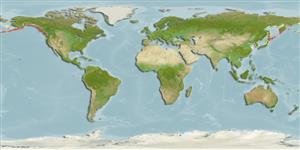Common names from other countries
Classification / Names / Names
Noms communs | Synonymes | Catalog of Fishes (gen., sp.) | ITIS | CoL | WoRMS
Environment: milieu / climate zone / depth range / distribution range
Écologie
; profondeur 0 - 40 m (Ref. 289). Polar
Arctic and Northern Pacific. Polar to boreal.
Length at first maturity / Taille / Poids / Âge
Maturity: Lm ? range ? - ? cm Max length : 1.7 cm TL mâle / non sexé; (Ref. 283)
Description synthétique
Morphologie
Most common in oyster beds and among growths of algae (Ref. 290). Girdle: narrow; closely beset with minute spines but appearing almost smooth to the naked eye. Surface: Smooth but under a lens the valves are finely granulated in quincunx. Lateral areas: Scarcely defined. Valve color: Olive-brown, streaked, maculated or clouded with blue or chestnut (Ref. 297).
Depth based on occurrence record; to be replaced with better reference. Most common in oyster beds and among growths of algae (Ref. 290). Found from subtidal to 40 m (Refs. 289, 75835).
Life cycle and mating behavior
Maturité | Reproduction | Frai | Œufs | Fécondité | Larves
Members of the class Polyplacophora are mostly gonochoric. Life cycle: Eggs hatch into lecitotrophic planktonic trocophore larvae (no veliger stage) which later metamorphose and settle on the bottom as young adults.
Slieker, F.J.A. 2004. (Ref. 289)
Statut dans la liste rouge de l'IUCN (Ref. 130435)
statut CITES (Ref. 108899)
Not Evaluated
Not Evaluated
Utilisations par l'homme
| FishSource |
Outils
Plus d'informations
Taille/ÂgeCroissanceLongueur-poidsLongueur-longueurMorphologieLarvesAbondance
Sources Internet
Estimates based on models
Preferred temperature
(Ref.
115969): 4.1 - 10, mean 7 (based on 108 cells).
Vulnérabilité
Low vulnerability (10 of 100).
Catégorie de prix
Unknown.
